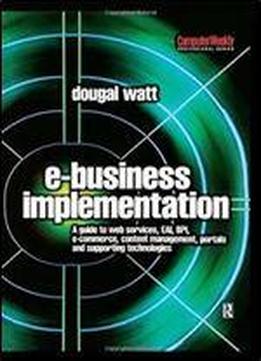
E-business Implementation: (computer Weekly Professional)
by Dougal Watt /
2003 / English / PDF
2.6 MB Download
'E-business Implementation' is written as a complete guide to successful e-business delivery, from both a project management and a detailed technological perspective. E-business provides a powerful mechanism for organizations to increase productivity and lower costs. However, in order to utilise these considerable benefits, companies must ensure their e-business is implemented correctly and is appropriate to their market segment. 'E-business Implementation' provides a comprehensive guide to successful implementation and is divided into three parts:* Part one begins with a project management structure designed to deliver successful e-business functionality within time and budget, while avoiding the high failure rates common to many technology projects.* Part two details key concepts, technologies, products, vendors, benefits, limitations, and high-level design architectures for e-business, in a phased and risk-managed approach. These include publishing through the Internet and Intranets, portals and content management systems, transacting using e-commerce, integrating internal enterprise applications, integrating with external partners and suppliers, and responding in real-time to changing levels of demand through dynamic e-business and web services. * Part three details a set of critical foundation technologies that must be implemented correctly for the e-business initiative to be successful. These technologies include e-business development languages such as Java, XML and .Net, hardware platforms and their operating systems, security and networking systems, the Internet Domain Name System, and Open Source technologies'E-business Implementation' is written as a complete guide to successful e-business delivery, from both a project management and a detailed technological perspective. E-business provides a powerful mechanism for organizations to increase productivity and lower costs. However, in order to utilise these considerable benefits, companies must ensure their e-business is implemented correctly and is appropriate to their market segment.
'E-business Implementation' provides a comprehensive guide to successful implementation and is divided into three parts:
* Part one begins with a project management structure designed to deliver successful e-business functionality within time and budget, while avoiding the high failure rates common to many technology projects.
* Part two details key concepts, technologies, products, vendors, benefits, limitations, and high-level design architectures for e-business, in a phased and risk-managed approach. These include publishing through the Internet and Intranets, portals and content management systems, transacting using e-commerce, integrating internal enterprise applications, integrating with external partners and suppliers, and responding in real-time to changing levels of demand through dynamic e-business and web services.
* Part three details a set of critical foundation technologies that must be implemented correctly for the e-business initiative to be successful. These technologies include e-business development languages such as Java, XML and .Net, hardware platforms and their operating systems, security and networking systems, the Internet Domain Name System, and Open Source technologies.










